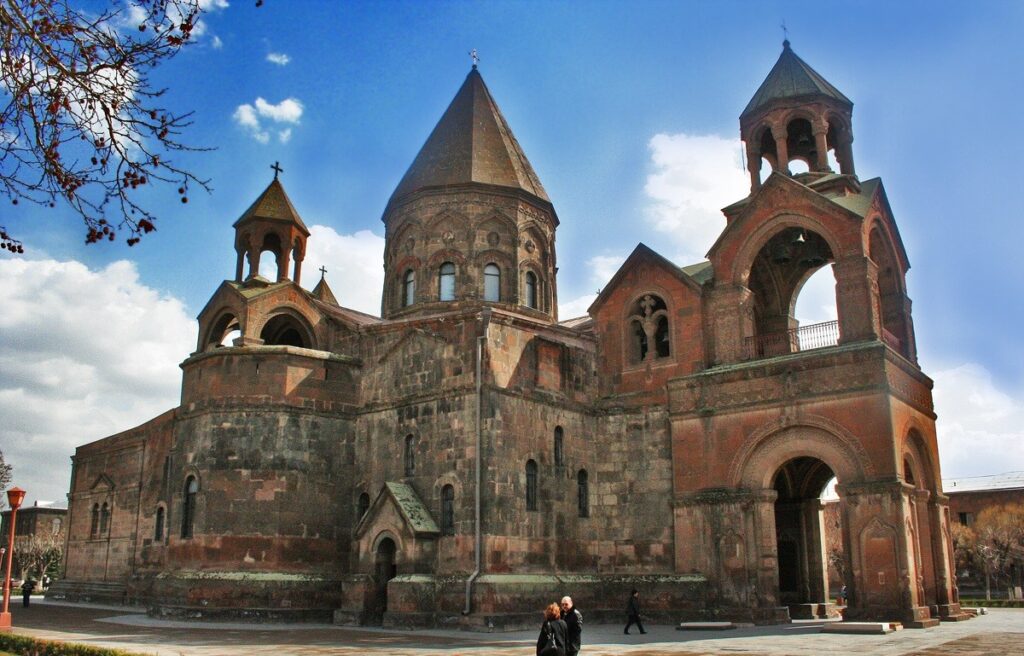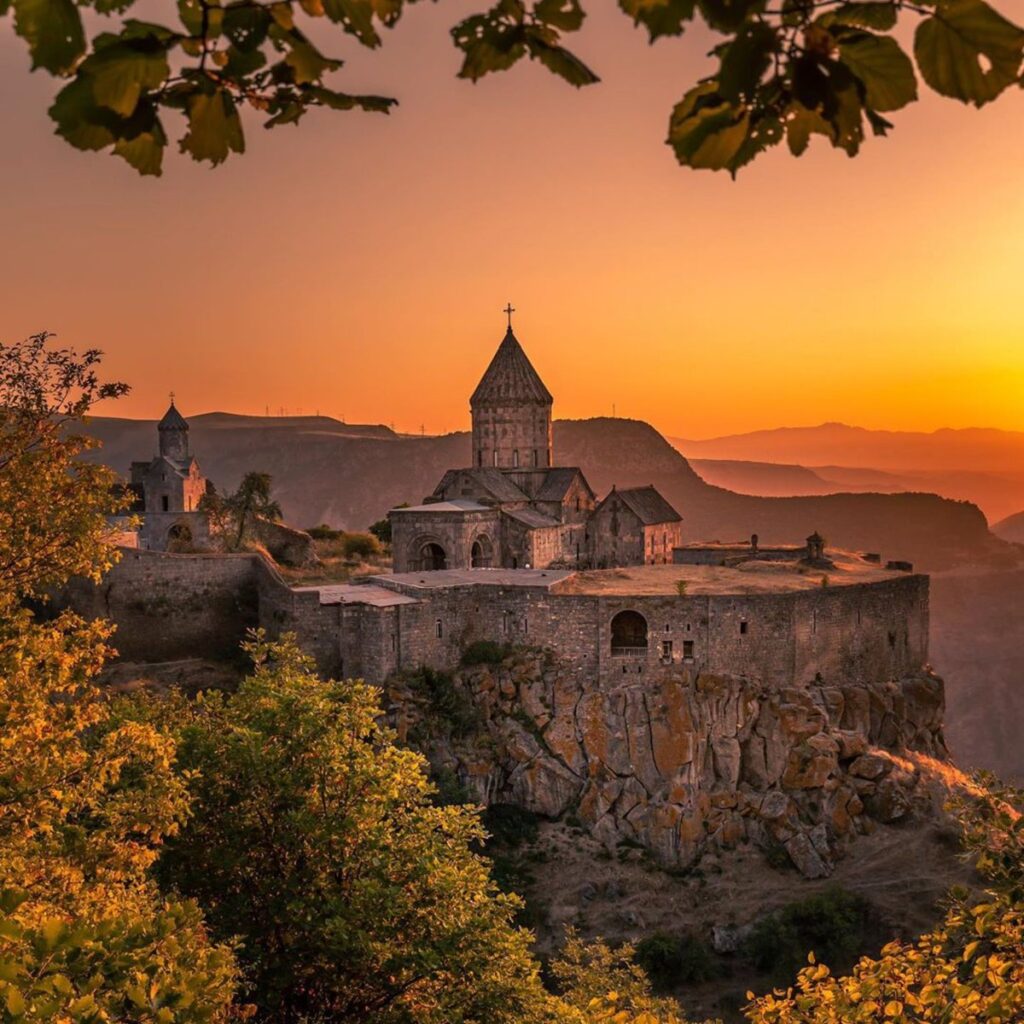This tour will drive you through the centuries of Armenian history. Getting acquainted with one of the oldest cities in the world, learning the history of Armenian Christianity, passing through the monastery where the first Armenian Catholicos was sentenced but stayed alive, seeing how Armenian architects created handicraft-like stone-cut churches, visiting one of the main centers of excellence of Armenian philosophy and many other discoveries will be imprinted in your memory.
Day 2 – Yerevan city tour
Breakfast in the hotel.
Round tour in Yerevan, one of ancient cities in the world. Yerevan was founded in 782 B.C. by the king of Urartu Argishti, it became the capital city for the first Republic of Armenia, later Soviet Armenia, and since 1991 it has been the capital of the current Republic of Armenia.
Walk in the center of the city, the main square of the city, the Opera and Ballet House, the Northern Avenue, as well as other structures.
History Museum of Armenia – History Museum represents a coherent picture of the culture and history of Armenia from ancient times till nowadays.
The Cascade Complex – The Complex represents a structure made up from huge stairs, while numerous fountains leave the impression of a waterfall. Cafesjian Center for the Arts is also located here. In the Cascade Complex one can see works of modern sculptors like F. Botero, J. Brychtová,S. Libenský, J. Plensa and many others.
The Armenian Genocide Museum and Memorial is dedicated to the memory of 1.5 million Armenians who were massacred by the Turks at the beginning of the 20th century.
Victory Park –here tourists can find the statue of Mother Armenia and the memorial complex dedicated to the memory of the soldiers who died in the Second World War. A magnificent view of the city opens up from here.
Accommodation in the hotel of Yerevan.
Day 3 – Echmiadzin – Garni – Geghard
After breakfast tourist will be taken to Echmiadzin.
Echmiadzin is the center of the Armenian Apostolic Church, as well as the Holy See of the head of the church – the Catholicos. The city is considered to be the spiritual capital of Armenia and is located 20km from Yerevan.
Echmiadzin Cathedral was constructed in 301-303 by the founder of the Armenian Apostolic Church and the first Catholicos Gregory the Enlightner. It is considered to be the first Christian church in the world. Inside the church one can find the Treasury (museum) where church relics are kept, among which tourists can see a fragment of Noah’s Ark, Holy Lance that was used by a roman soldier to pierce the side of Jesus Christ and other interesting objects.

St. Hripsime and St. Gayane churches – Hripsime and Gayane were hermit nuns and they were persecuted in the Roman Empire because they were Christians. They found a shelter in Armenia. These churches were constructed exactly in the sites where they were killed. The church of St. Hripsime has a great architectural value as represents one of the first samples of Armenian Church architecture.
Ruins of Zvartnots Temple – Zvartnots was constructed in 643-652, had a unique structure which was different from typical Armenian medieval churches. However, unfortunately, it got destroyed approximately in the 10th century. The ruins of the temple were found at the beginning of the 20th century, and a very little part of it is reconstructed.
Later tourists will drive to Kotayk region.
Geghard monastery – According to legends the monastery was founded in the 4th century, but nowadays surviving constructions belong to the 13th century. This unique structure, partially cut into the adjacent rock, is surrounded by high mountains. The monastery is included in UNESCO list of world heritage.
Garni Fortress – The territory of Garni fortress was inhabited in the ancient times, inscriptions from the times of the Kingdom of Urartu, as well as constructions belonging to different ages were found here. One of the most significant constructions is the 1st century pagan temple dedicated to the God of Sun Mitra. This temple is the only surviving example of a pagan temple in Armenia, as well as the only one constructed in Greek-Roman style. Tourists will also see the 2nd century bath.
Driving back to Yerevan. Accommodation in the hotel in Yerevan.
Day 4 – Yerevan – Khor Virap – Noravank – Karahunj – Goris
Breakfast in Yerevan, then tourists start their tour driving to Ararat region.
Khor Virap is situated on one of the hills of the historic city of Artashat. Gregory the Enlightner, the founder of the Armenian Apostolic Church, was imprisoned here in the pit for 13 years. The monastery is considered to be a pilgrimage site for the Armenians. An incredible view on the symbol of Armenia – Mount Ararat opens up from here. Unfortunately, the mountain now is not in the territory of Armenia.
We continue our tour towards Vayots-dzor region. After driving through the canyon of the river Amaghu we reach the Noravank monastic complex.
Noravank – Noravank was founded in the 13-14 centuries. The monastery is considered to be the pearl of the Armenian medieval architecture. The churches of the monastic complex have a specific architecture with majestic base-reliefs, one of which represents Father God which was a quite a brave action for medieval ages.
We will visit cave Areni 1 where different artifacts belonging to the bronze age were found in 2010. The oldest shoe in the world (5500 years old), a winery, burial place belonging to a young girl were among the findings.
You can also visit the studio of a sculptor which is situated nearby. The sculptor will show us the art of preparing Armenian khachkars. A khachkar is considered to be a type of fine arts of medieval Armenia; the constituent part of it is a cross carved in a stelle decorated with delicate ornaments. The art of preparing a khachkar entered the list of UNESCO’s non-material cultural heritage in 2010.
Driving towards Syunik region.
Karahunj – One of the world’s oldest megalithic monuments Zorats Karer (Karahunj) is situated near the city of Sisian. Zorats Karer dates back to the 6 millennium B.C. and according to some scholars it was used as an observatory. Many of the stones have holes in them which correspond to the exact location of the stars in those times. The scientists found the same type of structures in Europe as well. The most famous among them is Stonehenge (2 millennium B.C.)
Overnight in Goris.
Day 5 – Goris – Tatev – Selim – Noratus – Sevan – Dilijan
Breakfast in the hotel.
Tatev – We will visit Tatev monastery which is situated in Syunik region at the edge of the Vorotan river gorge. We will take aerial tramway listed in the world Guinness book as the longest tramway in the world (5.7 km) to reach the monastery. The existing Tatev monastery constructions belong to the 9-10 centuries. Tatev University was considered to be one of the most famous medieval educational centers.
We will continue our way to Gegharkunik region.
Orebelian Caravansaray – We will drive from Vayots dzor region to Gegharkunik region through Selim pass (2400 m). We will visit Caravanserai constructed by the Orbelian family (1332). The Silk Road passed through the territory of Armenia as well, that is why a lot of caravanserais were constructed here. The Orbelian Caravanserai is the best preserved one in the territory of Armenia.
Noratus – we will visit an ancient graveyard in Noratus which is famous for its numerous khachkars. The oldest khachkars date back to the 9th century.
Later we will visit Lake Sevan.
Lake Sevan is the largest lake in modern Armenia which occupies 5% of the territory of the country. It is situated in Gegharkunik region at 1900 meters above sea level. It’s the second largest alpine lake in the world after Lake Titicaca in South America.
Sevanavank monastery is in the peninsula of Sevan.
Sevanavank – the monastery was founded in the 4th century by Gregory the Enlightner, though the existing churches belong to the 9th century and were constructed by the princess of Armenia Mariam Bagratuni in memory of her husband.
We continue our tour towards Dilijan.
Dilijan is often called “little Armenian Switzerland” because of its wonderful nature.
Overnight in Dilijan.

Day 6 – Dilijan – Haghartsin – Goshavank
Breakfast in the hotel.
The monastic complex Haghatsin is situated in the forest 15 km away from Dilijan.
Haghartsin -The complex was formed by constructions belonging to different centuries and it consists of three churches, two narthexes (one is ruined), refectory, several chapels, khachkars and so on. The oldest construction in the complex is St. Gregory church (approximately X century). The most fascinating construction is the refectory which is a bright example of Armenian civil architecture.
Goshavank – Goshavank monastery (12-13th century) is situated 20 km away from Dilijan. In historic sources the monastery is referred to as school, academy, university, seminary. Among the subjects were languages – Armenian, as well as foreign languages (Greek, Latin), grammar, rhetoric, music, writing art and painting. Famous men of culture got educated and later worked here.
Tavush region is the place where the molokans, one of the minorities of Armenia, live. You will visit one of the molokan families, will get to know their history and traditions, will try a cup of tea with traditional sweets.
Driving back to Yerevan. Accommodation in Yerevan.
Day 7 – Yerevan
Transfer to the airport.
What if you could have a time machine that would drive you through the centuries of such an interesting history like Armenian? Here is how you can imagine that.

We believe Armenia to be one of the world’s great undiscovered tourism destinations and it is our passion to share this region with you.
We have assembled an all-star team of knowledgeable and service-oriented guides and staff members, who save no effort to make any visit to Armenia the most memorable and enjoyable one.
Contact Info